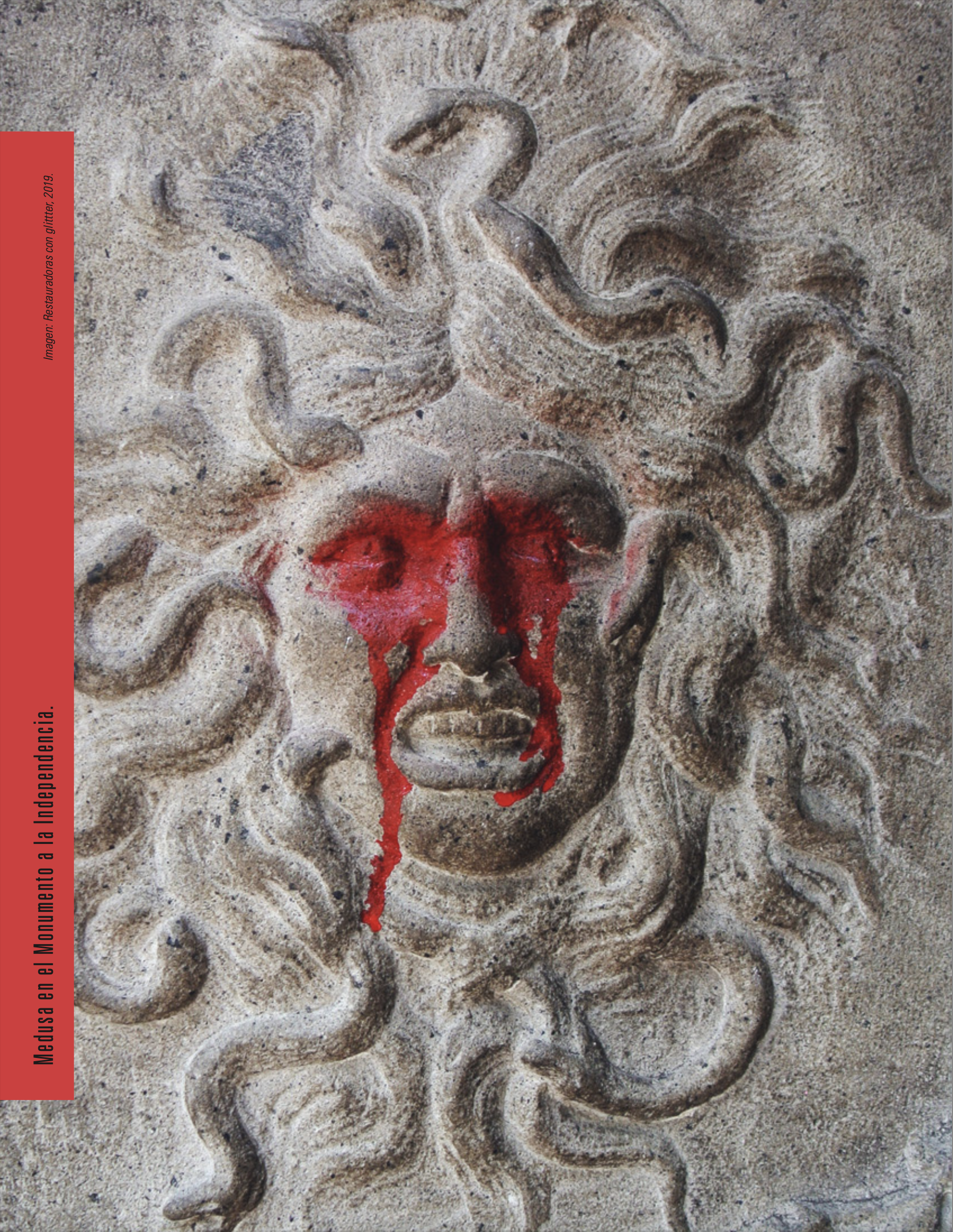Conservación como acción política. La alteridad que somos
Keywords:
demonstrations, neutrality, subalternity, alterity, memory, Restauradoras con glitterAbstract
This text shows some reflections of the authors that have motivated and emerged from their participation in the women’s collective Restauradoras con glitter, defining a professional and political position. This position was and is stated as a result of the interventions made by women on different monuments since August 2019 in response to misogynist violence and the aggressive criticism and judgments that, in response, an important part of the public opinion emitted. Our participation is also motivated by the consciousness that monuments can be used to communicate other messages than those communicated by the hegemonic discourse, and sustained from the institutions, without betraying the profession. On the contrary, we fully assume conservation as a social discipline. We address the concepts of alterity and subalternity, the notions of the impossibility of neutrality in conservation, along with the necessity of keeping the memory of our historical and social context, and the right to demonstration. We do not forget to point out the serious problems that women face in Mexico, and that it is possible to remove paint from surfaces, but not violence and murder.
Downloads
References
Balachandran, Sanchita (2016) “Race, diversity and politics in conservation: our 21st century crisis-Sanchita Balachandran”, en Conservators Converse. AIC’s blog archives 2008-2019 [blog], 25 de mayo, dispobible en: <http://resources.culturalheritage.org/conservators-converse/2016/05/25/race-diversity-and-politics-in-conservation-our-21st-century-crisis-sanchita-balachandran/> [consultado el 10 de octubre de 2020].
Blei, Daniela (2020) “The museum where racist and oppressive statues go to die. Germany has found ways to display problematic monuments without elevating them”, Atlas Obscura [en línea] (24 de agosto), disponible en: <https://www.atlasobscura.com/articles/museum-of-toxic-statues-berlin> [consultado el 13 de octubre de 2020].
Carta de México en defensa del patrimonio cultural (1976) Carta de México en defensa del patrimonio cultural [en línea], disponible en: <https://ipce.culturaydeporte.gob.es/dam/jcr:ac2be1f7-0204-4153-a77a-19d4e580bac9/1976-carta-mexico.pdf> [consultado el 11 de octubre de 2020].
Chávez-Aguayo, Marco Antonio, y Garduño Freeman, Cristina (2020) “Machismo and feminicide: Sharing culture and difficult heritage in Mexico”, Historic Environment, 32 (1): 36-53, disponible en: <https://australia.icomos.org/wp-content/uploads/Machismo-and-feminicide-Sharing-culture-and-diff%C2%8Cicult-heritage-in-Mexico-vol-32-no-1.pdf?fbclid=IwAR2-oMfb97t57L9JtRUq7pZDLzqP99Q b45l1VCyYmhmARlclMKiJv5T4p8U> [consultado el 12 de octubre de 2020].
Coles, Fran (2020) #Black Lives Matter: Documenting and conserving Bristol’s history as it happens, Fran Coles, Icon CCG [video en línea], disponible en: <https://www.youtube.com/watch?v=VLVjKmWu3Zw> [consultado el 13 de octubre de 2020].
Dobres, Marcia-Anne (2000) Technology and Social Agency: Outlining a Practice Framework for Archaeology, Oxford, Blackwell. Douglas, Mary, y Baron Isherwood (1990) [1979] El mundo de los bienes. Hacia una antropología del consumo, México, Grijalbo/Consejo Nacional para la Cultura y las Artes.
Durant, Fletcher (2019) Conservation is not neutral (And neither are we), [pdf] disponible en: <https://ufdc.ufl.edu/IR00010800/00001> [consultado el 15 de octubre de 2020].
El-Mecky, Nausikaä (2020) “Don’t Call it Vandalism”, Image Journal [en línea] (11 de junio), disponible en: [consultado el 13 de octubre de 2020].
González Esquer, Anahís (2020) Mujer Victoria-Restauradoas con Glitter [video en línea], disponible en: <https://www.youtube.com/ watch?v=pYEFxC8hLxU&feature=emb_logo> [consultado el 13 de octubre de 2020].
González Varela, Sergio (2018) “Repensando el concepto de Mesoamérica por medio del análisis antropológico de la materialidad y la memoria cultural”, Boletín de Antropología, 33 (56): 15-38.
Latour, Bruno (2003) Nunca hemos sido modernos. Ensayo de antropología simétrica, Madrid, Editorial Debate.
Latour, Bruno (2014) “Technical does not mean material, comment on Lemonnier, Pierre. 2012 Mundane objects: Materiality and non-verbal communication”, Journal of Ethnographic Theory, 4 (1): 507–510.
Lévinas, Emmanuel (1961) Totalite et Infini, La Haya, M. Nijhoff.
Malinowsky, Bronislaw (1986) [1922] Los argonautas del Pacífico occidental I. Un estudio sobre comercio y aventura entre los indígenas de los archipiélagos de la Nueva Guinea melanésica, Barcelona, Planeta/De Agostini.
Macdonald, Sharon (2016) “Is ‘difficult heritage’ still ‘difficult’? Why public acknowledgment of past perpetration may no longer be so unsettling to collective identities”, Museum International, 67 (1-4): 6-22.
Miller, Daniel (2005) “Materiality and introduction”, en Daniel Miller (ed.), Materiality, Londres, Duke University Press/Durham and London, pp. 1-50.
Palma, Francisca (2016) “Los intelecturales deberían trabajar para hacer intelectuales a los subalternos para que el mundo sea democrático”, Universidad de Chile [en línea] (25 de agosto), disponible en: <https://www.uchile.cl/noticias/125428/los-intelectuales-deberian-trabajar-para-subalternos-intelectuales> [consultado el 12 de octubre de 2020].
Restauradoras con glitter (RCG) (2019) Carta publicada el 21 de agosto de 2019, disponible en: <https://www.facebook.com/restauradoras.glitterMX/posts/100796064629472> [consultado el 10 de octubre de 2020].
Restauradoras con glitter (RCG) (2020) Feminismo: una lucha global [video en línea], disponible en: <https://www.facebook.com/restauradoras.glitterMX/posts/338690800839996> [consultado el 13 de octubre de 2020].
Sirenio, Kau (2020) “Voces indígenas sobre la estatua de Colón”, Pie de Página [en línea] (15 de octubre), disponible en: <https://piedepagina.mx/voces-indigenas-hablan-sobre-la-estatua-de-colon/?fbclid=IwAR1ZXt-dnw_7om_kaO3ntsQf5b1de_pqLtacVRlR-KcNXyVK2UcOfBBtsBM> [consultado el 15 de octubre de 2020].
Spivak, Gayatri (2013) “¿Podemos oír al subalterno?”, Clarín [en línea] (5 de noviembre), disponible en: <https://www.clarin.com/ideas/gayatri-spivak-entrevista_0_B1f-ZYGowmg.html>f [consultado el 14 de octubre de 2020].
Vázquez, Félix (2018) “Memoria social”, en Diccionario de la Memoria Colectiva, Barcelona, Ed.Gedisa, pp. 303-305.
Vázquez, Félix (2018b) “Resignificación”, en Diccionario de la Memoria Colectiva, Barcelona, Ed.Gedisa, pp. 422-423.
Zárate Toscano, Verónica (2003) “El papel de la escultura conmemorativa en el proceso de construcción nacional y su reflejo en la Ciudad de México en el siglo XIX”, Historia Mexicana, LIII (2): 417-446.



